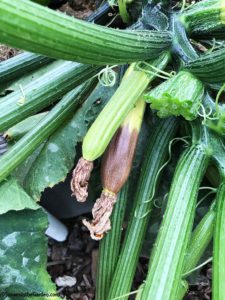Blossom End Rot – Not Just in Tomatoes!

 We gardeners are all familiar with blossom-end rot in tomatoes, right? Well, how about in zucchinis?
We gardeners are all familiar with blossom-end rot in tomatoes, right? Well, how about in zucchinis?
2017 marks the first time I’ve ever experienced this on my zucchini plants and I’m shocked! It’s been a hot, dry summer and apparently those plants decided the tomatoes shouldn’t have all the fun.
Initially, I was seeing some small, yellowing and shriveling zucchinis a couple of months ago and chalked it up to poor pollination. After all, you’ll often see zucchinis begin to grow, only to shrivel up and fall off, right?
But this was happening more often and seemed odd to me. A few small zucchinis had turned yellow and a couple of inches of each tip was brown and mushy. I kept thinking, “I really need to research this” but just didn’t have the time.
Until yesterday, that is. I finally did a little poking around on the web and when I did a search on zucchinis with brown tips, there it was: blossom-end rot. Ugh. The odd thing is that I grew the same variety (‘Clarimore’) last summer, when it was also very hot, but didn’t have this problem so it isn’t necessarily a variety susceptible to it.
So what causes blossom-end rot, anyway? When a plant is developing fruits (i.e., young tomatoes), one of the substances that goes into growing them is calcium. So the plant is essentially routing calcium to those fruits.
But, if the weather is hot and the plants are irregularly or insufficiently watered, the plants go into survival mode. They tell those developing fruits, “sorry, guys, but the plant takes precedence and we need to survive, so you don’t get to have calcium anymore.” (you probably didn’t even know they had these conversations, right?)
Once that source of calcium is gone, the fruits struggle to grow and that’s where that ugly black end comes from.
Our vegetable garden is watered with a drip irrigation system that is on a timer. When the weather kept getting hotter and hotter, my husband Bill increased the amount of water the garden was getting. In theory, that should’ve prevented this problem, but maybe the zucchini plants needed more water? I don’t know.
Regarding our tomato plants, there hasn’t been any instance of blossom-end rot. That’s partly because the varieties I’m growing (‘Sungold’ cherry, ‘Chef’s Choice Orange’ slicing, and ‘Amish Paste Kapuler’) all seem to be resistant to it. But the other thing I did while preparing the beds for planting was to add calcium to the soil. I purchased a bag of calcium from Gardens Alive, in case you’re wondering, but you can probably find it at well-stocked garden centers, too.
The good news about our zucchini plants is that we’ve been getting plenty of perfectly normal squash from them. So why are some affected and not others? I have no idea! But I’m thankful we’re still getting a bountiful harvest from them.
Other vegetables that can be affected by blossom-end rot are peppers, melons and cucumbers, in case you’re curious.
I found an excellent explanation of blossom-end rot from Missouri Extension that is well worth reading; just click on the link.
